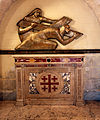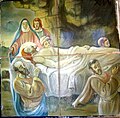Stations of the Cross

| Part of a series on |
| Devotions to Jesus in the Catholic Church |
|---|
 |
| Devotions |
|
| Prayers |
|
|
|
The Stations of the Cross or the Way of the Cross, also known as the Way of Sorrows or the Via Crucis, are a series of images depicting
Commonly, a series of 14 images will be arranged in numbered order along a path, along which worshippers—individually or in a procession—move in order, stopping at each station to say prayers and engage in reflections associated with that station. These devotions are most common during Lent, especially on Good Friday, and reflect a spirit of reparation for the sufferings and insults that Jesus endured during his passion.[7][8][9] As a physical devotion involving standing, kneeling and genuflections, the Stations of the Cross are tied with the Christian themes of repentance and mortification of the flesh.[1][10]
The style, form, and placement of the stations vary widely. The typical stations are small plaques with reliefs or paintings placed around a church nave. Modern minimalist stations can be simple crosses with a numeral in the centre.[7][11] Occasionally the faithful might say the stations of the cross without there being any image, such as when the pope leads the stations of the cross around the Colosseum in Rome on Good Friday.[12]
History

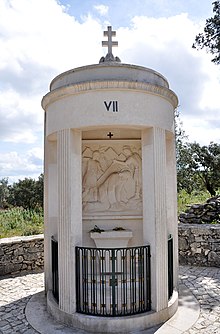
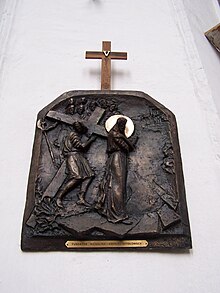
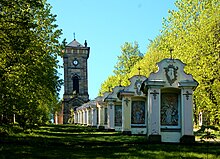
The Stations of the Cross originated from the
Following the
During the 15th and 16th centuries, the Franciscans began to build a series of outdoor shrines in Europe to duplicate their counterparts in the Holy Land. The number of stations at these shrines varied between seven and thirty; seven was common. These were usually placed, often in small buildings, along the approach to a church, as in a set of 1490 by
In 1686, in answer to their petition, Pope Innocent XI granted to the Franciscans the right to erect stations within their churches. In 1731, Pope Clement XII extended to all churches the right to have the stations, provided that a Franciscan father erected them, with the consent of the local bishop. At the same time the number of stations was fixed at fourteen. In 1857, the bishops of England were allowed to erect the stations by themselves, without the intervention of a Franciscan priest, and in 1862 this right was extended to bishops throughout the church.[17]
Stations

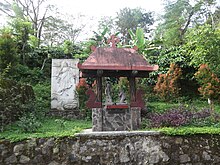
The early set of seven scenes was usually numbers 2, 3, 4, 6, 7, 11 and 14 from the list below.[16] From the late 16th century to the present, the standard complement has consisted of 14 pictures or sculptures depicting the following scenes:[18][19][20]
- Jesus is condemned to death
- Jesus takes up his Cross
- Jesus falls the first time
- Jesus meets his Mother
- Simon of Cyrene helps Jesus carry the Cross
- Veronica wipes the face of Jesus
- Jesus falls for the second time
- Jesus meets the women of Jerusalem
- Jesus falls for the third time
- Jesus is stripped of his garments (sometimes called the "Division of Robes")
- Jesus is nailed to the Cross
- Jesus dies on the Cross
- Jesus is taken down from the Cross
- Jesus is laid in the tomb
Although not traditionally part of the Stations, the Resurrection of Jesus is sometimes included as an unofficial fifteenth station.[dubious ][21][22] One very different version, called the Via Lucis ("Way of Light"), comprising the Fourteen Stations of Light or Stations of the Resurrection, starts with Jesus rising from the dead and ends with Pentecost.[23]
Scriptural form
Out of the fourteen traditional Stations of the Cross, only eight have a clear scriptural foundation. Station 4 appears out of order from scripture; Jesus's mother is present at the crucifixion but is only mentioned after Jesus is nailed to the cross and before he dies (between stations 11 and 12). The scriptures contain no accounts whatsoever of any woman wiping Jesus's face nor of Jesus falling as stated in Stations 3, 6, 7 and 9. Station 13 (Jesus's body being taken down off the cross and laid in the arms of his mother Mary) differs from the gospels' record, which states that Joseph of Arimathea took Jesus down from the cross and buried him.
To provide a version of this devotion more closely aligned with the biblical accounts, Pope John Paul II introduced a new form of devotion, called the Scriptural Way of the Cross, on Good Friday 1991. He celebrated that form many times but not exclusively at the Colosseum in Italy,[24][25] using the following sequence (as published by the United States Catholic Conference of Bishops):[26]
- Jesus prays in the Garden of Gethsemane;
- Jesus is betrayed by Judas and arrested;
- Jesus is condemned by the Sanhedrin;
- Jesus is denied by Peter three times;
- Jesus is judged by Pilate;
- Jesus is scourged and crowned with thorns;
- Jesus takes up his cross;
- Jesus is helped by Simon of Cyrene to carry his cross;
- Jesus meets the women of Jerusalem;
- Jesus is crucified;
- Jesus promises his kingdom to the repentant thief;
- Jesus entrusts Mary and John to each other;
- Jesus dies on the cross; and
- Jesus is laid in the tomb.
In 2007, Pope Benedict XVI approved this set of stations for meditation and public celebration.[27][28]
The New Way of the Cross (Philippines)
Another set of Stations are being used by the Catholic Church in the Philippines. Filipinos use this set during Visita Iglesia, which is usually done every Holy Week.
- The Last Supper
- The Agony in Gethsemane
- Jesus Before the Sanhedrin
- Jesus is scourged and crowned with thorns
- Jesus Receives His Cross
- Jesus Falls under the weight of the Cross
- Simon of Cyrene Helps Jesus carry the Cross
- Jesus meets the women of Jerusalem
- Jesus is nailed to the Cross
- The Repentant Thief
- Mary and John at the Foot of the Cross
- Jesus dies on the Cross
- Jesus is laid in His Tomb
- Jesus rises from the Dead
Modern usage

In the Roman Catholic Church, the devotion may be conducted personally by the faithful, making their way from one station to another and saying the prayers, or by having an officiating celebrant move from cross to cross while the faithful make the responses. The stations themselves must consist of, at the very least, fourteen wooden crosses—pictures alone do not suffice—and they must be blessed by someone with the authority to erect stations.[29]
Pope John Paul II led an annual public prayer of the Stations of the Cross at the Roman Colosseum on Good Friday. Originally, the pope himself carried the cross from station to station, but in his last years when age and infirmity limited his strength, John Paul presided over the celebration from a stage on the Palatine Hill, while others carried the cross. Just days prior to his death in 2005, Pope John Paul II observed the Stations of the Cross from his private chapel. Each year a different person is invited to write the meditation texts for the Stations. Past composers of the Papal Stations include several non-Catholics. The pope himself wrote the texts for the Great Jubilee in 2000 and used the traditional Stations.
The celebration of the Stations of the Cross is especially common on the Fridays of Lent, especially Good Friday. Community celebrations are usually accompanied by various songs and prayers. Particularly common as musical accompaniment is the
Structurally, Mel Gibson's 2004 film, The Passion of the Christ, follows the Stations of the Cross.[30]
Debates
Place of Christ's resurrection
Some modern liturgists
The
Music
Franz Liszt wrote a Via Crucis for choir, soloists and piano or organ or harmonium in 1879. In 1931, French organist Marcel Dupré improvised and transcribed musical meditations based on fourteen poems by Paul Claudel, one for each station.
As the Stations of the Cross are prayed during the season of Lent in Catholic churches, each station is traditionally followed by a verse of the
Literature
Dimitris Lyacos' third part of the Poena Damni trilogy, The First Death, is divided into fourteen sections in order to emphasise the "Via Dolorosa" of its marooned protagonist during his ascent on the mount of the island which constitutes the setting of the work.[38]
Gallery
-
1st Station: Jesus is condemned to death
-
2nd Station: Jesus takes up his Cross
-
3rd Station:Jesus falls for the first time
-
4th Station: Jesus meets his Mother
-
5th Station: Simon of Cyrene helps Jesus carry the Cross
-
6th Station: Veronica wipes the face of Jesus
-
7th Station: Jesus falls for the second time
-
8th Station: Jesus meets the women of Jerusalem
-
9th Station: Jesus falls for the third time
-
10th Station: Jesus is stripped of his garments (sometimes called the "Division of Robes")
-
11th Station: Jesus is nailed to the Cross
-
12th Station: Jesus dies on the cross
-
13th Station: Jesus is taken down from the Cross
-
14th Station: Jesus is laid in the tomb
See also
- Acts of Reparation to Jesus Christ
- Life of Jesus in the New Testament
- Seven Sorrows of Mary
- Sayings of Jesus on the cross
- Three Hours' Agony
- Via Lucis
- Mysteries of the Rosary
References
- ^ ISBN 978-0-8294-5327-0.
- ^ "Stations of the Cross". Holy Trinity Lutheran Church. Archived from the original on 20 October 2017. Retrieved 20 October 2017.
- ^ "Good Friday: Stations of the Cross Explained". Sinclair Broadcast Group, Inc. (KJZZ14). 15 April 2022.
It has become standard for Catholic churches in the United States to mark the Stations of the Cross on Good Friday. In addition to Catholics, some Protestant churches, especially those belonging to the Episcopal [i.e., Anglican] or Lutheran denominations, also commemorate the Stations of the Cross as of their Lenten activities.
- ^ "Lent" (PDF). Church of England. 236. Archived from the original (PDF) on 5 July 2017. Retrieved 20 October 2017.
- ^ "Stations of the Cross". Trinity UMC. 24 March 2013. Archived from the original on 17 April 2015. Retrieved 17 April 2015.
- ^ Quann, Lynn (4 April 2017). "Stations of the Cross". Epworth United Methodist Church. Archived from the original on 26 March 2023. Retrieved 16 April 2022.
- ^ a b "Stations of the Cross". St. Michael's Episcopal Church. 2012. Archived from the original on 17 February 2015. Retrieved 3 March 2015.
- ISBN 0-87973-910-X
- ^ The Catholic Prayer Book and Manual of Meditations (1883) by Patrick Francis Moran /The Way of the Cross. Browne and Nolan.
- ^ Ryder, Henry Ignatius Dudley (1920). Sermons and Notes of Sermons. Sands & Company. p. 58.
- ISBN 978-1-317-54557-6.
- ^ "Frommer's Events – Event Guide: Good Friday Procession in Rome (Palatine Hill, Italy)". Frommer's. Archived from the original on 7 January 2009. Retrieved 8 April 2008.
- S2CID 191752841.
- ^ ISBN 978-0-520-08213-7.
- ^ OCLC 843213.
- ^ ISBN 0-85331-324-5
- ^ The Catholic Encyclopedia (1907). s.v. "The Way of the Cross".
- ^ "Text of the Stations of the Cross for 2020, led by Pope Francis". Aleteia / Foundation for Evangelization through the Media (FEM). 9 April 2020. Retrieved 19 May 2020.
- ^ "First Station: Jesus is condemned to death". Libreria Editrice Vaticana. Retrieved 19 May 2020.
- ^ Francesca Merlo (10 April 2020). "Way of the Cross: Meditations from a corrections facility". Vatican News. Retrieved 19 May 2020.
- ^ "Fr. William Saunders". Archived from the original on 2009-04-30. Retrieved 2009-04-04.
Because of the intrinsic relationship between the passion and death of our Lord with His resurrection, several of the devotional booklets now include a 15th station, which commemorates the Resurrection.
- ^ Ficcaglia, Jennifer (12 February 2016). "Stations of the Cross Explained". Catholic Courier.
The Way of the Cross traditionally consists of 14 iconic stations that depict the events of Jesus' journey to crucifixion. A 15th station, which is not depicted by an icon, is meant to remember Jesus' resurrection.
- ^ "The Official Web Site for the Archdiocese of Detroit" (PDF). Archived from the original (PDF) on 2010-12-23. Retrieved 2012-02-13.
In some contemporary Stations of the Cross, a fifteenth station has been added to commemorate the Resurrection of the Lord.
- ISBN 0-89243-679-4
- ^ Pope John Paul II, Meditation and Prayers for the Stations of the Cross at the Colosseum Archived 2013-06-03 at the Wayback Machine, Good Friday, 2000
- ^ "Scriptural Stations of the Cross". www.usccb.org. Retrieved 2019-03-11.
- Vatican.va. Archivedfrom the original on July 7, 2013. Retrieved February 18, 2018.
- ^ "Pope Benedict leads Good Friday service". ABC News. April 6, 2007 – via www.abc.net.au.
- ^ "Catholic Encyclopedia: Way of the Cross". Newadvent.org. 1912-10-01. Retrieved 2014-07-03.
- ^ Review Archived 2012-04-30 at the Wayback Machine, United States Conference of Catholic Bishops, 2004
- ISBN 978-0-06-065338-5.
- ^ Peter Maxwell Davies: Composer's note in the published score (Boosey and Hawkes, B & H 20286).
- ^ Cavanagh, David (February 1997). "ChangesFiftyBowie". Q magazine: 52–59.
- ^ "Via Crucis by Paweł Łukaszewski". www.viacrucis.pl.
- ^ Falcon Valley Music Ed., Stefano Vagnini, Via Crucis, Rome, 2002.[not specific enough to verify]
- ^ "Esce il primo disco del compositore e pianista astigiano Fabio Mengozzi, elettronica e magia". La Stampa (in Italian). 18 October 2022.
- ^ "The Stations of the Cross : Clarion Review". www.clarionreview.org. Retrieved 2017-12-16.
- ^ Toti O’Brien (October 2018). "Poena Damni/Poetry Review - Ragazine". Retrieved 2024-01-21.
External links
- Scriptural Stations of the Cross from the United States Conference of Catholic Bishops
- The Way Of The Cross: Presentation (historical development; present form, both traditional and scriptural), from the official Vatican website (accessed 19 May 2020)
- Via Crucis celebration texts used by the Vatican on Good Fridays since 1991 from the official Vatican website
- Video: Corine Schleif. Adam Kraft's Seven Falls of Christ. Walking the History of Emotions in Nuremberg. Part 1
- Video: Corine Schleif. Adam Kraft's Seven Falls of Christ. Walking the History of Emotions in Nuremberg. Part 2
- "Way of the Cross" article from The Catholic Encyclopedia





